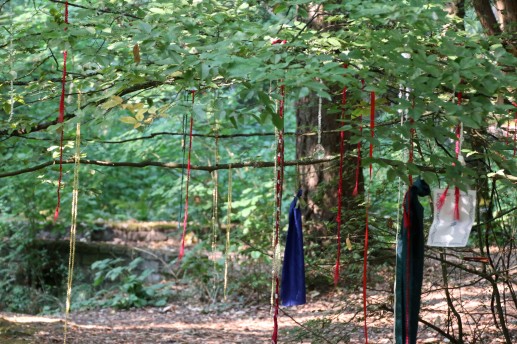
That’s one of dozens of short poems on cards lining a path into Camp Long as you enter this weekend’s Arts In Nature Festival, presented by the Nature Consortium. It’s on until 9 tonight and again from 11 am-6 pm tomorrow, and it’s a chance to immerse yourself in art experiences of many kinds, from words to music to ethereal creations woven between tree branches:

You might find performance artists wandering the grounds, like this otherworldly duo:

We first encountered them by a work in progress that’s unfolding all weekend long:

The painting started between two trees and will grow, we were told, to show how the built environment is obscuring nature and greenspaces; go see for yourself by the cabin between the north end of the meadow and the south side of the pond. Some of the comforts of civilization, though, are lining the central meadow – food trucks including the vegan Luchador Taco Company:

There’s a beer garden behind Camp Long’s historic lodge, too. Wander the grounds and you’ll find something to see, do, or hear, almost everywhere – at the small amphitheater on the south side of the meadow, we found these musicians:
Be sure to take several turns around the festival grounds – you might miss something behind a curtain or around the bend, first time you pass. Here’s the full schedule; ticket information is here – online sales are over but you can pay at the tent just past the gates of the park, which is at 5200 35th SW.

| 6 COMMENTS